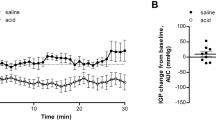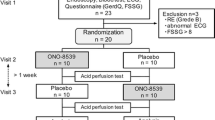Abstract
Using a canine chambered stomach preparation, the effects of topical 16,16-dimethyl-prostaglandin E2 (dmPGE2) on gastric mucosal morphology, H+ loss and HCO3 − secretion were assessed. Compared to control studies in which acid alone (100 mM HCl) bathed the epithelium, dmPGE2 (1 or 4 μg/ml), when applied to gastric mucosa in acid medium, significantly (P<0.01) enhanced H+ loss from the bathing solution in a dose-related fashion. These effects, however, were independent of any injury to the epithelium as confirmed by both light and electron microscopy. In other studies in which dmPGE2 was applied to gastric mucosa in neutral solution (150 mM NaCl, pH 7.0) using identical doses, a dose-related increase (P<0.01) in HCO3 − secretion was observed. When the net HCO3 − output (μEq/15 min) for each dose of dmPGE2 employed was compared with the net H+ loss (μEq/15 min) for each dose of PG used, no differences were noted. The correlation between H+ loss and HCO3 − secretion was highly significant (r=0.87;P<0.01). We conclude that with the doses studied, dmPGE2 is not damaging to gastric mucosa and that the apparent increase in H+ loss elicited by dmPGE2 in acid medium is due to acid neutralization secondary to HCO3 − secretion.
Similar content being viewed by others
References
Miller TA, Jacobson ED: Gastrointestinal cytoprotection by prostaglandins. Gut 20:75–87, 1979
Robert A: Prostaglandins and the gastrointestinal tract.In Physiology of the Gastrointestinal Tract, LR Johnson (ed). New York, Raven Press, 1981, pp 1407–1434
Robert A: Cytoprotection by prostaglandins. Gastroenterology 77:761–767, 1979
Robert A: Antisecretory, antiulcer, cytoprotective and diarrheogenic properties of prostaglandins.In Advances in Prostaglandin and Thromboxane Research, Vol 2. B Samuelsson, R Paoletti (ed.). New York, Raven Press, 1976, pp 507–521
Robert A, Schultz JR, Nezamis JE, Lancaster C: Gastric antisecretory and antiulcer properties of PGE2, 15-methyl PGE2, and 16,16-dimethyl-PGE2. Intravenous, oral and intrajejunal administration. Gastroenterology 70:359–370, 1976
Robert A, Magerlein BJ: 15-methyl PGE2 and 16,16-dimethyl-PGE2: Potent inhibitors of gastric secretion. Adv Biosci 9:247–253, 1973
O'Brien PE, Carter DC: Effect of gastric secretory inhibitors on the gastric mucosal barrier. Gut 16:437–442, 1975
Bolton JP, Cohen MM: Permeability effects of E2 prostaglandins on canine gastric mucosa. Gastroenterology 70:865, 1976 (abstract)
Cheung LY, Lowry SF, Perry J, Larson K: Topical effects of 16,16-dimethyl prostaglandin E2 on gastric acid secretion and mucosal permeability to hydrogen ion in dogs. Gut 19:775–778, 1978
Davenport HW, Warner HA, Code CF: Functional significance of gastric mucosal barrier to sodium. Gastroenterology 47:142–152, 1964
Bolton JP, Cohen MM: Stimulation of non-parietal cell secretion in canine Heidenhain pouches by 16,16-dimethyl prostaglandin E2. Digestion 17:291–299, 1978
Kauffman GL, Reeve JJ, Grossman MI: Gastric bicarbonate secrétion: Effect of topical and intravenous 16,16-dimethyl prostaglandin E2. Am J Physiol 239:G44-G48, 1980
Miller TA, Watkins LA, Henagan JM: 16,16-dimethyl PGE2 stimulates bicarbonate secretion in the canine stomach. Surg For 31:126–129, 1980
Garner A, Heylings JR: Stimulation of alkaline secretion in amphibian-isolated gastric mucosa by 16,16-dimethyl PGE2 and PGF2α. Gastroenterology 76:497–503, 1979
Mao CC, Shanbour LL, Hodgins DC, Jacobson ED: Adenosine 3′,5′-monophosphate (cyclic AMP) and secretion in the canine stomach. Gastroenterology 63:427–438, 1972
Cheung LY: Topical effects of 16,16-dimethyl prostaglandin E2 on gastric blood flow in dogs. Am J Physiol 238:G514-G519, 1980
McGreevy JM, Moody FG: A mechanism for prostaglandin cytoprotection. Br J Surg 67:873–876, 1980
Author information
Authors and Affiliations
Additional information
This work was supported by Research Grant AM 25838 from the National Institute of Arthritis, Metabolism and Digestive Diseases.
Rights and permissions
About this article
Cite this article
Miller, T.A., Balfour Kraemer, B., Henagan, J.M. et al. Topical 16,16-dimethyl-prostaglandin E2 . Digest Dis Sci 28, 641–648 (1983). https://doi.org/10.1007/BF01299925
Received:
Revised:
Accepted:
Issue Date:
DOI: https://doi.org/10.1007/BF01299925




